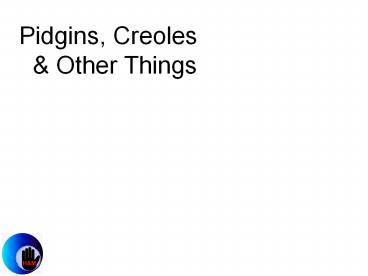Pidgins, Creoles - PowerPoint PPT Presentation
Title:
Pidgins, Creoles
Description:
Pidgins are organized human communication, created from multiple languages, ... taught English, but that they ended oralism, and allowed the use of signing back ... – PowerPoint PPT presentation
Number of Views:1634
Avg rating:3.0/5.0
Title: Pidgins, Creoles
1
Pidgins, Creoles Other Things
2
Natural Pidgins and Creoles Pidgins are organized
human communication, created from multiple
languages, which draw their vocabulary from one
language, and their syntax and pronunciation from
the remaining languages.
One superstrate language Lg of power, but
limited access Many substrate languages Lgs of
migrant workers/refugees
3
Definition of Language (revisited) Language is
the systematic use of symbols to express and
perceive information between members of a
community, in which the system is rule-governed,
has infinite production possibilities, is
intergenerational, and changes over time.
A Creole is a pidgin that has been passed on to a
second generation. Creolization is the process
of birthing a new language.
4
Esperanto, Gestuno and International
Signing Esperanto created by Polish physician
Ludwig L. Zamenhoff in 1887 Gestuno created by
World Federation of the Deaf committee in
1973 International Signing is the spontaneous
pidginization of signed languages that occurs at
international deaf gatherings. Some instances of
International Signing are based on Gestuno
5
Artificial Intermodal Pidgins Created for
educational purposes, to teach English Unfortunat
ely, ASL serves as superstrate (vocabulary) while
English and manual inventions serve as substrates
(word order, pronunciation). Therefore human
brains interacting with Artificial Intermodal
Pidgins will work toward ASL features rather than
English features, thus defeating the purpose of
the AIPs.
6
Artificial Intermodal Pidgins
7
Artificial Intermodal Pidgins
The value of the AIPs was not that they taught
English, but that they ended oralism, and allowed
the use of signing back into the education of
deaf children. Each AIP was careful to include
the word English which eased the concerns of
administrators. SEE1 (Seeing Essential English)
and LOVE (Linguistics of Visual English) both
avoided using the word Sign. SEE2 (Signing
Exact English) was based more strongly on ASL
morphology, and thus received greater acceptance
over SEE1, which was actually more true to
English phonology.
8
- Review Questions
- 1. How do natural pidgins develop?
- 2. What is the difference between a pidgin and a
creole? - How are Esperanto and Gestuno similar to and
different from pidgins? - 4. When were Esperanto and Gestuno created?
- 5. How is International Signing different from
Gestuno? - 6. Which encoding mechanisms represent elements
of English in manual/English Artificial Pidgins? - 7. Which encoding mechanisms represent elements
of ASL in manual/English Artificial Pidgins? - 8. Who was the initial creator of American manual
English codes? - 9. What was the original name of the first
American manual English code and what was it
later changed to? - 10. Why do manual English codes not actually
encode English?
9
- Suggested Activities
- Make up a (pseudo) pidgin language of your own.
Take the vocabulary of a spoken language (such as
French, German, or Spanish) and put them in
English word order. Change the pronunciation to
American English speech patterns. - 2. Find a guidebook for either SEE1 or SEE2 (or
another Artificial Pidgin) and figure out how to
express the following sentences using them - a. Yesterday I saw five goats.
- b. I finished eating two hours before I swam.
- c. The darkness of the coming night made us
feel sheepish.































![[PDF]❤️DOWNLOAD⚡️ Comparative Creole Syntax: Parallel Outlines of 18 Creole Grammars PowerPoint PPT Presentation](https://s3.amazonaws.com/images.powershow.com/10039152.th0.jpg?_=20240525037)